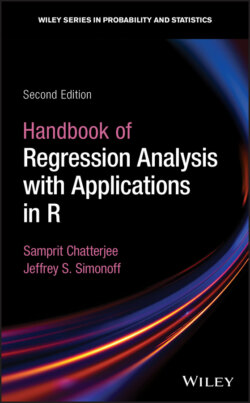Читать книгу Handbook of Regression Analysis With Applications in R - Samprit Chatterjee - Страница 20
1.3.1 INTERPRETING REGRESSION COEFFICIENTS
ОглавлениеThe least squares regression coefficients have very specific meanings. They are often misinterpreted, so it is important to be clear on what they mean (and do not mean). Consider first the intercept, .
1 : The estimated expected value of the target variable when the predictors are all equal to zero.
Note that this might not have any physical interpretation, since a zero value for the predictor(s) might be impossible, or might never come close to occurring in the observed data. In that situation, it is pointless to try to interpret this value. If all of the predictors are centered to have zero mean, then necessarily equals , the sample mean of the target values. Note that if there is any particular value for each predictor that is meaningful in some sense, if each variable is centered around its particular value, then the intercept is an estimate of when the predictors all have those meaningful values.
The estimated coefficient for the th predictor () is interpreted in the following way:
1 : The estimated expected change in the target variable associated with a one unit change in the th predicting variable, holding all else in the model fixed.
There are several noteworthy aspects to this interpretation. First, note the word associated — we cannot say that a change in the target variable is caused by a change in the predictor, only that they are associated with each other. That is, correlation does not imply causation.
Another key point is the phrase “holding all else in the model fixed,” the implications of which are often ignored. Consider the following hypothetical example. A random sample of college students at a particular university is taken in order to understand the relationship between college grade point average (GPA) and other variables. A model is built with college GPA as a function of high school GPA and the standardized Scholastic Aptitude Test (SAT), with resultant least squares fit
It is tempting to say (and many people would say) that the coefficient for SAT score has the “wrong sign,” because it says that higher values of SAT are associated with lower values of college GPA. This is not correct. The problem is that it is likely in this context that what an analyst would find intuitive is the marginal relationship between college GPA and SAT score alone (ignoring all else), one that we would indeed expect to be a direct (positive) one. The regression coefficient does not say anything about that marginal relationship. Rather, it refers to the conditional (sometimes called partial) relationship that takes the high school GPA as fixed, which is apparently that higher values of SAT are associated with lower values of college GPA, holding high school GPA fixed. High school GPA and SAT are no doubt related to each other, and it is quite likely that this relationship between the predictors would complicate any understanding of, or intuition about, the conditional relationship between college GPA and SAT score. Multiple regression coefficients should not be interpreted marginally; if you really are interested in the relationship between the target and a single predictor alone, you should simply do a regression of the target on only that variable. This does not mean that multiple regression coefficients are uninterpretable, only that care is necessary when interpreting them.
Another common use of multiple regression that depends on this conditional interpretation of the coefficients is to explicitly include “control” variables in a model in order to try to account for their effect statistically. This is particularly important in observational data (data that are not the result of a designed experiment), since in that case, the effects of other variables cannot be ignored as a result of random assignment in the experiment. For observational data it is not possible to physically intervene in the experiment to “hold other variables fixed,” but the multiple regression framework effectively allows this to be done statistically.
Having said this, we must recognize that in many situations, it is impossible from a practical point of view to change one predictor while holding all else fixed. Thus, while we would like to interpret a coefficient as accounting for the presence of other predictors in a physical sense, it is important (when dealing with observational data in particular) to remember that linear regression is at best only an approximation to the actual underlying random process.
